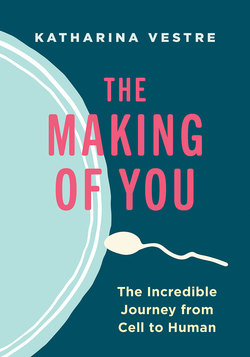Читать книгу The Making of You - Katharina Vestre - Страница 5
На сайте Литреса книга снята с продажи.
ОглавлениеWHEN I WAS six years old I collected hotel soaps, played with Barbie dolls and wore flashing sneakers. My taste in movies was exceptionally unoriginal and can be summed up as ‘anything with princesses’. But my favourite book? Pregnancy and Birth: A Practical Handbook for All Future Parents. My sister and I would take it down from the bookshelf, skim past all the dietary advice and stop when we reached page 70: The foetus as it grows. Fascinated, we would follow the illustrations of this tiny creature as it increased in size, thinking of our own brother-to-be curled up inside our mother’s tummy. We learned how he was transforming from a strange, primitive little animal with a tail into a chubby baby with arms and legs, confined in a space barely large enough to accommodate him. How was this possible?
Seventeen years passed before I returned to this question. I was completing a bachelor’s degree in biochemistry at the University of Oslo, and sitting up late in the library one night, reading about cell biology. In my textbook was a series of images showing how a hand is formed in the uterus. At first it resembles a duck’s foot, and then the fingers gradually appear. In the caption I read that this transformation was due to mass cell suicide. Many years ago, all the cells that linked my fingers together died, on command from their neighbours, and left me with the hands I’m writing with now.
This detail, I realised, was not included on page 70: The foetus as it grows. The pictures I’d seen as a six-year-old told only a small part of the story. How does this tiny creation actually come about? What happens in the cells, and in the DNA molecules? How does a hand know that it’s going to be a hand and not a foot or an ear, for example?
In search of answers, I began digging through syllabus books and research articles. It wasn’t long before I became completely immersed. Prior to the summer vacation in 2015, I borrowed three huge embryology books from the library at Oslo University Hospital and took them with me on holiday to Italy. My internet search history filled up with egg cells and foetuses. Google drew its own conclusions and began showing adverts for baby creams (I don’t like to think what their algorithms made of my searches for fruit flies, fish kidneys and the gender development of sea worms).
The result of all this was the book you now hold in your hands. It is a story about distant relatives, unknown twins, dangerous placentas and strange insects. And I can say right now – without giving too much away – that it is all about you. Let me tell you about the beginning of your life.
Before we begin: a few words about time and size
WHILE WORKING ON this book, I discovered that trying to state the age of a foetus is fraught with difficulty. There are various chronological calculations involved, and it’s not unusual for them to get mixed up. Doctors and midwives commonly use the week of pregnancy, which is calculated from the last menstruation. However, conception usually occurs about two weeks after this, so it’s not until a woman begins her third ‘week of pregnancy’ that she’s actually pregnant. In other words, the foetus is two weeks younger than the week of pregnancy: at the end of the twelfth week of pregnancy, the foetus is ten weeks old; at the end of the fourteenth week it’s twelve weeks old, and so on.
I’ve chosen to use the conception as my starting point, so that all the time references I give reflect the real age of the foetus. Next, what is meant by a ‘month’? I have counted each month as a four-week period rather than a calendar month. Thus the first month comprises weeks one to four, the second weeks five to eight and so on.
When I state the length of a foetus I mean the measurement from its crown to its rump. (You will sometimes hear this referred to as CRL, crown-rump length.) This measurement is preferred because the legs of a foetus are often bent upwards, making it difficult to establish its length from head to toe.
Finally, please keep in mind that all time and size references are based on average values, and that every foetus develops at a slightly different rate. So, with that said, I think we’re ready to begin.
